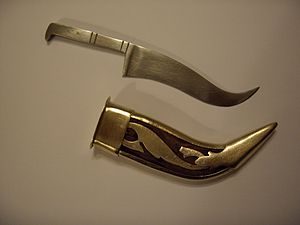Kirpan
| Kirpan | |
|---|---|

|
|
| Information | |
| Weapon type: | Dagger, short sword |
| Designations: | Kirpan |
| Use: | Religious and ceremonial weapon |
| Working time: | til today |
| Region of origin / author: |
India , follower of the Sikh religion |
| Distribution: | worldwide |
| Overall length: | 8 cm to about 10 cm |
| Handle: | metal |
| Particularities: | many different versions |
| Lists on the subject | |

A kirpan is a dagger or short sword that is worn by all baptized Sikh members for religious reasons, but originally arose from a weapon of war.
It serves as a symbol of the readiness to fight for self-defense and also to protect the faith. The symbolic form of the kirpan is also worn as a brooch on the commonly used traditional combs (ind. Khangha) as an engraving and often as a miniature.
The Kirpan is also a component of the Khanda Symbol, the Sikh consisting of a Khanda sword in the middle, a Chakram by the sword and two lying Kirpans is depending on both sides. It symbolizes the worldly and the spiritual authority ( Miri and Piri ).
description
The blade of the kirpan is usually made of iron or steel, particularly valuable versions were and are made of wootz . The blade usually begins wide at the handle and becomes narrower towards the location . The shapes of the blades vary.
In older, historical models, the blade is slightly curved upwards over the entire length of the blade, similar to a saber, and ends in a sharp point.
Newer versions have adopted this blade shape, but have also developed other shapes. The most common versions today have a blade length of around 8 cm to around 10 cm. The blade becomes narrower from the handle, the edge and the back of the blade run upwards in a wave. The cutting edge rises sharply towards the place, as does the back of the blade, and both converge to the place that protrudes far above the blades. The blades are mostly smooth, without a hollow grind or a fuller.
The handle is usually made of different metals, but wood or horn is also used. Depending on the version, it is available with or without a hand bar.
The pommel can be simple and smooth, but also in the shape of a lion's head (Indian Singh = lion, for the Sikh male name). Often there is also a Koftgari style ornament.
The scabbards are mostly made of metal (brass, copper, silver), but also of wood and are fastened in a band made of fabric that is worn over the right shoulder and is called "Gatra". Other versions have a flamed blade or are equipped with modern, less traditional shapes that are freely designed by the manufacturers.

A kirpan owned by the Sikh guru Gobind Singh Ji ( Punjabi : ਗੁਰੂ ਗੋਬਿੰਦ ਸਿੰਘ; * December 22, 1666 in Patna ; † October 7, 1708 ) has a rare, straight and double-edged blade that, unlike today's versions, was used and constructed as a weapon of war. This kirpan is in the museum of Anandpur Sahib / India together with Gobind Singh's large collection of weapons.
Nowadays there are legal disputes over the kirpan in many countries as the Sikhs wear it at any time of the day or night and in all places. This often leads to police operations when Sikhs are seen wearing the dagger in public places and buildings. In Canada, wearing the kirpan in public buildings such as courthouses has been approved by a police ordinance, but there is a length limit that must be adhered to. The total length must not exceed 20 cm and the blade length 10 cm.
Web links
- Kirpan at SikhiWiki
- Historical kirpan, booklet with a knuckle-bow at Blogspot.com
- Magnificent version of a kirpan from the personal possession of Sri Guru Gobind Singh Ji at Blogspot.com
- Double-edged straight kirpan owned by Sri Guru Gobind Singh Ji, believed to be a weapon of war on Blogspot.com
- Kirpan with flamed blade at Nihangsingh.com
- Kirpan with Damascus blade (Wootz) and Koftgari ornamentation at Ancientpoint.com
- Miniature kirpan at Sikhsiyasat.net
Individual evidence
- ^ HS Singha: The Encyclopedia of Sikhism. Hemkunt Press, New Delhi 2000, page 127 f, ISBN 978-81-7010-301-1
- ^ Julia Neuberger, Caring for Dying People of Different Faiths , Radcliffe Publishing, 2004, page 56, ISBN 978-1-85775-945-7
- ↑ Oxford Textbook of Palliative Care for Children , Oxford Textbook Series, editors Ann Goldman, Richard Hain, Stephen Liben, Oxford University Press, 2006, page 218, ISBN 978-0-19-852653-7
- ↑ Oxford Textbook of Palliative Care for Children , Oxford Textbook Series, editors Ann Goldman, Richard Hain, Stephen Liben, Oxford University Press, 2006, page 218, ISBN 978-0-19-852653-7
- ^ Julia Neuberger, Caring for Dying People of Different Faiths , Radcliffe Publishing, 2004, page 56, ISBN 978-1-85775-945-7
- ↑ Toronto Star newspaper website (accessed November 8, 2013)